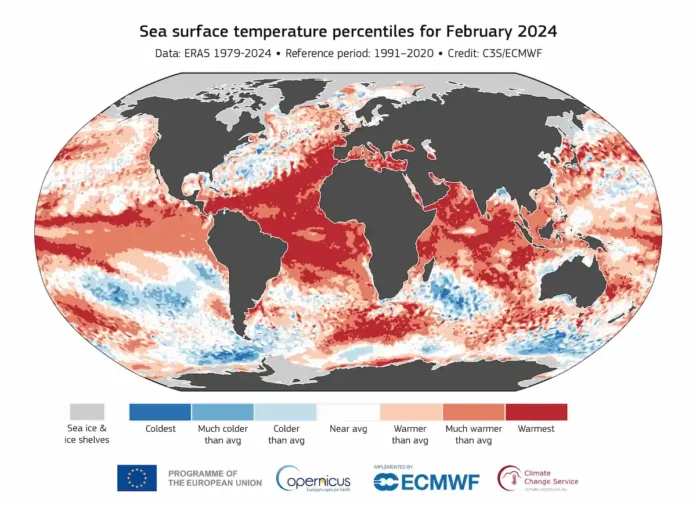24 Predicted To Be Warmest: For the first time in almost a year, the Earth did not establish a new monthly global temperature record. However, Earth saw its two hottest days on record in July, and it is becoming more probable that 2024 will be the warmest year on record, according to a recent analysis from Copernicus, the European Union’s Climate Change Service.
Last month was both the second-warmest July and the second-warmest overall month on record worldwide, bringing an end to 13 months of record-breaking global temperature readings for each month of the year, according to the study, which was issued Wednesday.
Scientists predict a modest dip in world average temperature when El Niño ends and La Niña develops in the tropical eastern Pacific in the coming months.
Despite other factors causing shorter-term changes, the long-term global average temperature trend continues to rise as a result of human-caused climate change.
“The basic background remains unchanged; our climate continues to warm. Climate change’s disastrous consequences began far before 2023 and will continue until global greenhouse gas emissions reach net zero,” Samantha Burgess, Copernicus’ deputy director, said in a statement.
Although July 2024 was not as warm as July 2023 on average, Earth saw two of its hottest days on record in July, according to the Copernicus ERA5 data record.
On July 22, the daily worldwide average temperature was 17.16 degrees Celsius (62.89 degrees Fahrenheit), while on July 23, it was 17.15 degrees Celsius (62.87 degrees Fahrenheit). Given the slight discrepancy, the research concluded that it is impossible to say definitively which was the hottest.
Copernicus researchers think 2024 is more likely to be the hottest year on record. The year-to-date worldwide average temperature anomaly through the end of July is presently ranked.27 degrees Celsius (.49 degrees Fahrenheit) warmer than the same time in 2023.
To prevent 2024 from being warmer than 2023, the average anomaly for the remaining months of this year would need to fall by at least.23 degrees Celsius, or.41 degrees Fahrenheit. This has seldom occurred in the organization’s ERA5 dataset.
According to the National Oceanic and Atmospheric Organization (NOAA), the last cooler-than-average year on Earth occurred in 1976.
According to the research, the average surface air temperature in July 2024 was 16.91 degrees Celsius (62.44 degrees Fahrenheit), slightly short of the all-time highs established in July 2023.
The overall temperature for the month was 1.48°C, or 2.66 degrees Fahrenheit, higher than an estimate of the July average from 1850 to 1900, the pre-industrial reference period established by the Paris Agreement.
According to the research, the worldwide average temperature for the last year, August 2023 to July 2024, was 1.64 degrees Celsius, or 2.95 degrees Fahrenheit, higher than the pre-industrial normal.
The Paris Agreement’s aims seek to reduce global warming to 1.5 degrees Celsius above pre-industrial levels.
Scientists point out that surpassing the 1.5 degree Celsius warming barrier momentarily is not considered a failure under the Paris pact since the pact considers the global average over numerous decades. However, short-term breaches of the barrier are an important indicator that greater averages are likely to occur in the next decade if emissions are not drastically lowered.
Global daily sea surface temperatures throughout the majority of the world’s seas remain much higher than normal. The average worldwide sea surface temperature in July 2024, between latitudes 60 degrees south and 60 degrees north, was 69.58 degrees Fahrenheit, the research revealed, the second-highest number on record for the month.
According to Copernicus, this ends 15 months of record-breaking sea surface temperature measurements for each month of the year.
However, continuous maritime heatwaves are maintaining sea surface temperatures around record levels in several regions of the world. This is especially worrying for forecasters who monitor the tropics and the condition of the world’s coral reefs.
According to the National Hurricane Center, tropical storm activity in the Atlantic Basin often increases rapidly in August, leading up to the season’s peak on September 10. Persistent near-record water temperatures in the Atlantic were one of the key reasons that prompted analysts to offer the highest-ever May prediction, predicting a highly active season.
Persistent maritime heatwaves also pose a significant threat to the world’s coral reefs. In April, NOAA stated that the second worldwide coral reef bleaching event in the recent decade had beginning.
Antarctic sea ice extent fell to its second-lowest level on record in July, 11% below normal. According to Copernicus, Arctic sea ice extent was 7% lower than the monthly average and lower than the levels reported in July 2022 and 2023.
